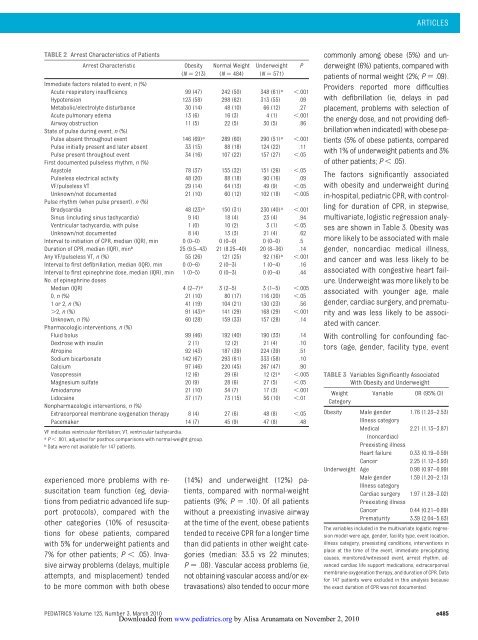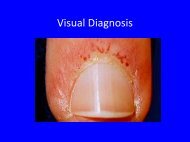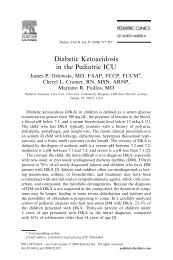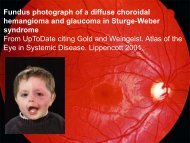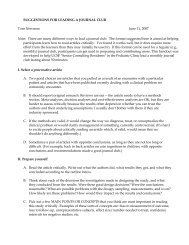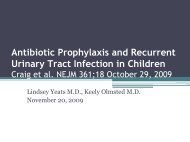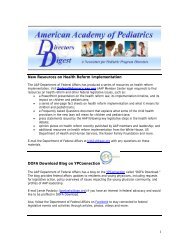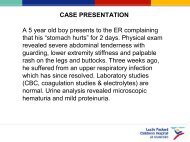DOI: 10.1542/peds.2009-1324 2010;125;e481-e488; originally ...
DOI: 10.1542/peds.2009-1324 2010;125;e481-e488; originally ...
DOI: 10.1542/peds.2009-1324 2010;125;e481-e488; originally ...
Create successful ePaper yourself
Turn your PDF publications into a flip-book with our unique Google optimized e-Paper software.
TABLE 2 Arrest Characteristics of Patients<br />
Arrest Characteristic Obesity<br />
(N 213)<br />
experienced more problems with resuscitation<br />
team function (eg, deviations<br />
from pediatric advanced life support<br />
protocols), compared with the<br />
other categories (10% of resuscitations<br />
for obese patients, compared<br />
with 5% for underweight patients and<br />
7% for other patients; P .05). Invasive<br />
airway problems (delays, multiple<br />
attempts, and misplacement) tended<br />
to be more common with both obese<br />
Normal Weight<br />
(N 484)<br />
Underweight<br />
(N 571)<br />
Immediate factors related to event, n (%)<br />
Acute respiratory insufficiency 99 (47) 242 (50) 348 (61) a .001<br />
Hypotension 123 (58) 298 (62) 313 (55) .09<br />
Metabolic/electrolyte disturbance 30 (14) 48 (10) 66 (12) .27<br />
Acute pulmonary edema 13 (6) 16 (3) 4 (1) .001<br />
Airway obstruction<br />
State of pulse during event, n (%)<br />
11 (5) 22 (5) 30 (5) .86<br />
Pulse absent throughout event 146 (69) a 289 (60) 290 (51) a .001<br />
Pulse initially present and later absent 33 (15) 88 (18) 124 (22) .11<br />
Pulse present throughout event<br />
First documented pulseless rhythm, n (%)<br />
34 (16) 107 (22) 157 (27) .05<br />
Asystole 78 (37) 155 (32) 151 (26) .05<br />
Pulseless electrical activity 48 (20) 88 (18) 90 (16) .09<br />
VF/pulseless VT 29 (14) 64 (13) 49 (9) .05<br />
Unknown/not documented<br />
Pulse rhythm (when pulse present), n (%)<br />
21 (10) 60 (12) 102 (18) .005<br />
Bradycardia 48 (23) a 150 (31) 230 (40) a .001<br />
Sinus (including sinus tachycardia) 9 (4) 18 (4) 23 (4) .94<br />
Ventricular tachycardia, with pulse 1 (0) 10 (2) 3 (1) .05<br />
Unknown/not documented 8 (4) 13 (3) 21 (4) .62<br />
Interval to initiation of CPR, median (IQR), min 0 (0–0) 0 (0–0) 0 (0–0) .5<br />
Duration of CPR, median (IQR), minb 25 (9.5–43) 21 (8.25–40) 20 (8–36) .14<br />
Any VF/pulseless VT, n (%) 55 (26) 121 (25) 92 (16) a .001<br />
Interval to first defibrillation, median (IQR), min 0 (0–6) 2 (0–3) 1 (0–4) .16<br />
Interval to first epinephrine dose, median (IQR), min<br />
No. of epinephrine doses<br />
1 (0–5) 0 (0–3) 0 (0–4) .44<br />
Median (IQR) 4 (2–7) a 3 (2–5) 3 (1–5) .005<br />
0, n (%) 21 (10) 80 (17) 116 (20) .05<br />
1or2,n (%) 41 (19) 104 (21) 130 (23) .56<br />
2, n (%) 91 (43) a 141 (29) 168 (29) .001<br />
Unknown, n (%)<br />
Pharmacologic interventions, n (%)<br />
60 (28) 159 (33) 157 (28) .14<br />
Fluid bolus 99 (46) 192 (40) 190 (33) .14<br />
Dextrose with insulin 2 (1) 12 (2) 21 (4) .10<br />
Atropine 92 (43) 187 (39) 224 (39) .51<br />
Sodium bicarbonate 142 (67) 293 (61) 333 (58) .10<br />
Calcium 97 (46) 220 (45) 267 (47) .90<br />
Vasopressin 12 (6) 29 (6) 12 (2) a .005<br />
Magnesium sulfate 20 (9) 28 (6) 27 (5) .05<br />
Amiodarone 21 (10) 34 (7) 17 (3) .001<br />
Lidocaine<br />
Nonpharmacologic interventions, n (%)<br />
37 (17) 73 (15) 56 (10) .01<br />
Extracorporeal membrane oxygenation therapy 8 (4) 27 (6) 48 (8) .05<br />
Pacemaker 14 (7) 45 (9) 47 (8) .48<br />
VF indicates ventricular fibrillation; VT, ventricular tachycardia.<br />
a P .001, adjusted for posthoc comparisons with normal-weight group.<br />
b Data were not available for 147 patients.<br />
(14%) and underweight (12%) patients,<br />
compared with normal-weight<br />
patients (9%; P .10). Of all patients<br />
without a preexisting invasive airway<br />
at the time of the event, obese patients<br />
tended to receive CPR for a longer time<br />
than did patients in other weight categories<br />
(median: 33.5 vs 22 minutes;<br />
P .08). Vascular access problems (ie,<br />
not obtaining vascular access and/or extravasations)<br />
also tended to occur more<br />
P<br />
ARTICLES<br />
commonly among obese (5%) and underweight<br />
(6%) patients, compared with<br />
patients of normal weight (2%; P .09).<br />
Providers reported more difficulties<br />
with defibrillation (ie, delays in pad<br />
placement, problems with selection of<br />
the energy dose, and not providing defibrillation<br />
when indicated) with obese patients<br />
(5% of obese patients, compared<br />
with 1% of underweight patients and 3%<br />
of other patients; P .05).<br />
The factors significantly associated<br />
with obesity and underweight during<br />
in-hospital, pediatric CPR, with controlling<br />
for duration of CPR, in stepwise,<br />
multivariate, logistic regression analyses<br />
are shown in Table 3. Obesity was<br />
more likely to be associated with male<br />
gender, noncardiac medical illness,<br />
and cancer and was less likely to be<br />
associated with congestive heart failure.<br />
Underweight was more likely to be<br />
associated with younger age, male<br />
gender, cardiac surgery, and prematurity<br />
and was less likely to be associated<br />
with cancer.<br />
With controlling for confounding factors<br />
(age, gender, facility type, event<br />
TABLE 3 Variables Significantly Associated<br />
With Obesity and Underweight<br />
Weight<br />
Category<br />
Variable OR (95% CI)<br />
Obesity Male gender<br />
Illness category<br />
1.76 (1.23–2.53)<br />
Medical<br />
(noncardiac)<br />
Preexisting illness<br />
2.21 (1.13–3.87)<br />
Heart failure 0.33 (0.19–0.59)<br />
Cancer 2.25 (1.12–3.93)<br />
Underweight Age 0.98 (0.97–0.99)<br />
Male gender<br />
Illness category<br />
1.59 (1.20–2.13)<br />
Cardiac surgery<br />
Preexisting illness<br />
1.97 (1.28–3.02)<br />
Cancer 0.44 (0.21–0.89)<br />
Prematurity 3.39 (2.04–5.63)<br />
The variables included in the multivariate logistic regression<br />
model were age, gender, facility type, event location,<br />
illness category, preexisting conditions, interventions in<br />
place at the time of the event, immediate precipitating<br />
causes, monitored/witnessed event, arrest rhythm, advanced<br />
cardiac life support medications, extracorporeal<br />
membrane oxygenation therapy, and duration of CPR. Data<br />
for 147 patients were excluded in this analysis because<br />
the exact duration of CPR was not documented.<br />
PEDIATRICS Volume <strong>125</strong>, Number 3, March <strong>2010</strong> e485<br />
Downloaded from<br />
www.pediatrics.org by Alisa Arunamata on November 2, <strong>2010</strong>


